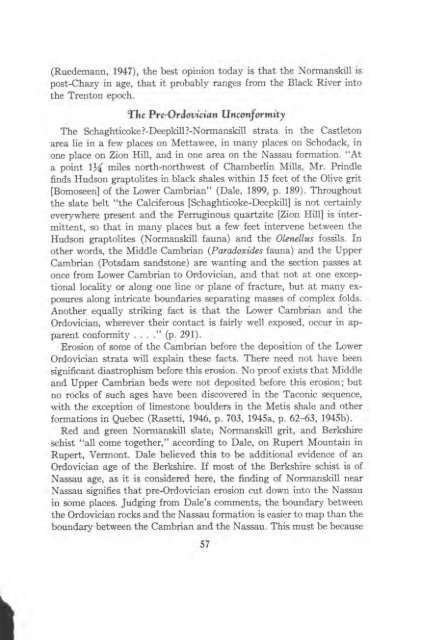STRATIGRAPHY AND STRUCTURE CASTLETON AREA VERMONT
STRATIGRAPHY AND STRUCTURE CASTLETON AREA VERMONT
STRATIGRAPHY AND STRUCTURE CASTLETON AREA VERMONT
You also want an ePaper? Increase the reach of your titles
YUMPU automatically turns print PDFs into web optimized ePapers that Google loves.
(Ruedemann, 1947), the best opinion today is that the Norrnanskill is<br />
post-Chazy in age, that it probably ranges from the Black River into<br />
the Trenton epoch.<br />
The Pre-Ordovician Unconformity<br />
The Schaghticoke ?-Deepkill ?-Normanskill strata in the Castleton<br />
area lie in a few places on Mettawee, in many places on Schodack, in<br />
one place on Zion Hill, and in one area on the Nassau formation. "At<br />
a point IY4 miles north-northwest of Chamberlin Mills, Mr. Prindle<br />
finds Hudson graptolites in black shales within 15 feet of the Olive grit<br />
[Bomoseen] of the Lower Cambrian" (Dale, 1899, p. 189). Throughout<br />
the slate belt "the Calciferous [Schaghticoke-Deepkill] is not certainly<br />
everywhere present and the Ferruginous quartzite [Zion Hill] is intermittent,<br />
so that in many places but a few feet intervene between the<br />
Hudson graptolites (Normanskill fauna) and the Olenellus fossils. In<br />
other words, the Middle Cambrian (Paradoxides fauna) and the Upper<br />
Cambrian (Potsdam sandstone) are wanting and the section passes at<br />
once from Lower Cambrian to Ordovician, and that not at one exceptional<br />
locality or along one line or plane of fracture, but at many exposures<br />
along intricate boundaries separating masses of complex folds.<br />
Another equally striking fact is that the Lower Cambrian and he<br />
Ordovician, wherever their contact is fairly well exposed, occur in apparent<br />
conformity ......(p. 291).<br />
Erosion of some of the Cambrian before the deposition of the Lower<br />
Ordovician strata will explain these facts. There need not have been<br />
significant diastrophism before this erosion. No proof exists that Middle<br />
and Upper Cambrian beds were not deposited before this erosion; but<br />
no rocks of such ages have been discovered in the Taconic sequence,<br />
with the exception of limestone boulders in the Metis shale and other<br />
formations in Quebec (Rasetti, 1946, p. 703, 1945a, p. 62-63, 1945b).<br />
Red and green Normanskill slate ; Normanskill grit, and Berkshire<br />
schist "all come together," according to Dale, on Rupert Mountain in<br />
Rupert, Vermont. Dale believed this to be additional evidence of an<br />
Ordovician age of the Berkshire. If most of the Berkshire schist is of<br />
Nassau age, as it is considered here, the finding of Normanskill near<br />
Nassau signifies that pre-Ordovician erosion cut down into the Nassau<br />
in some places. Judging from Dale's comments, the boundary between<br />
the Ordovician rocks and the Nassau formation is easier to map than the<br />
boundary between the Cambrian and the Nassau. This must be because<br />
57













